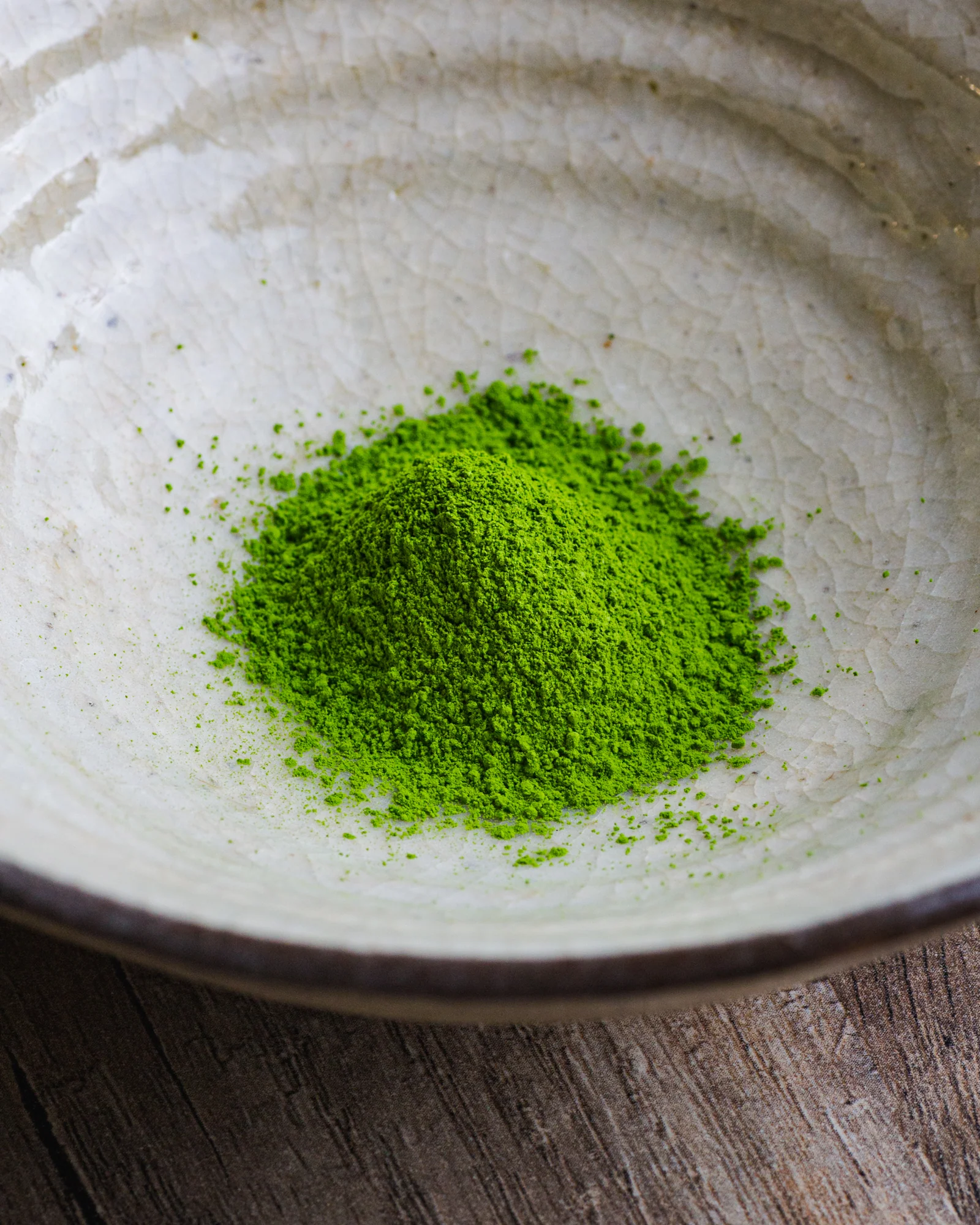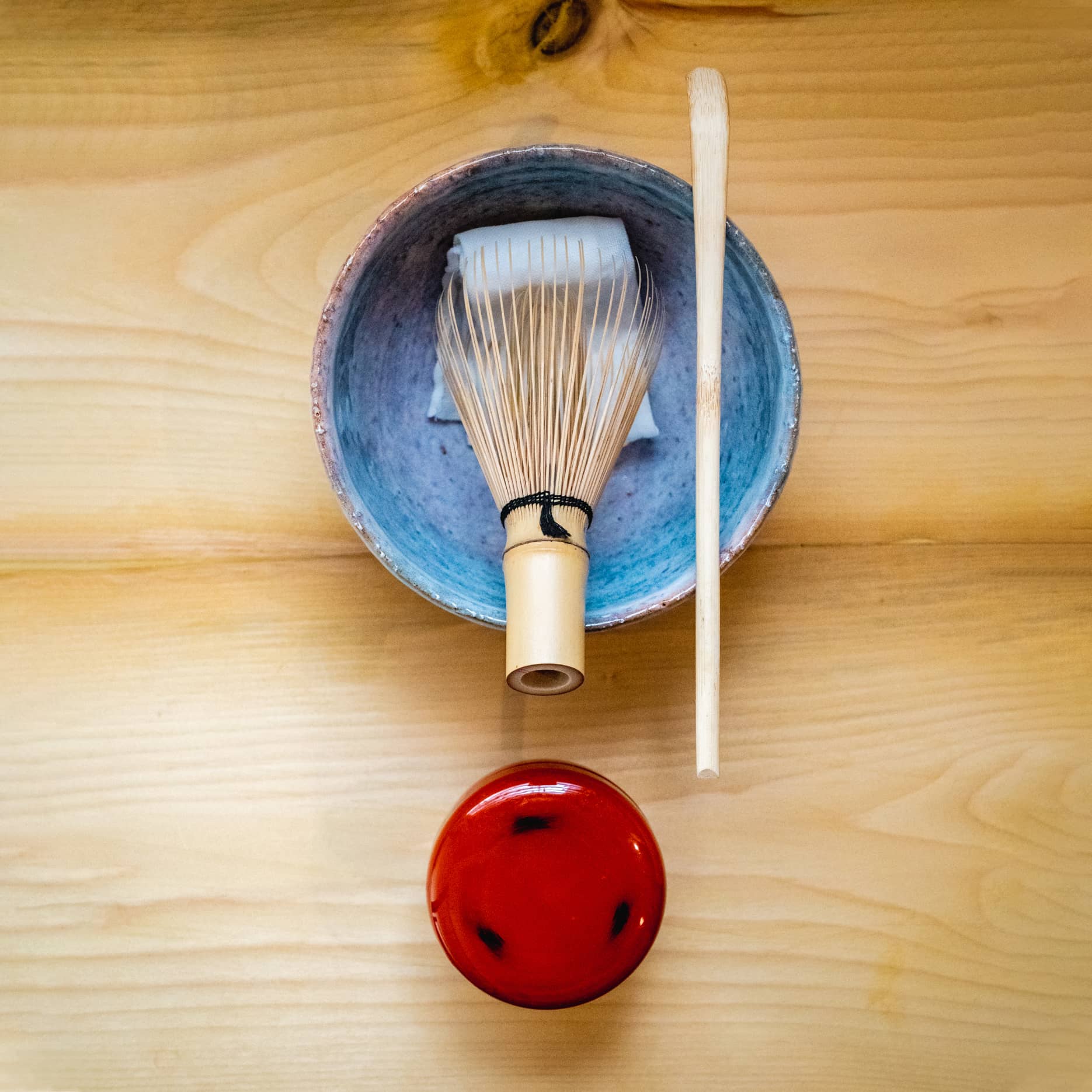Introducing Matcha to your Café Menu

As the wave of matcha mania continues to sweep across the world, it has become increasingly easy to find matcha and matcha-based drinks at cafés and restaurants. However, many establishments fail to take this tea seriously, treating it as a simple add-on to their menu, and not giving it the same care and attention as they might their espresso or filter coffee options. Here, we’ll take a look at how to incorporate matcha into a café’s drink lineup and workflow as simply as possible, without sacrificing quality and customer experience.
The Equipment
Matcha can be intimidating due to the unique and unfamiliar equipment required to make it well. Compared to espresso, however, it is rather simple and straightforward. Here’s what you’ll need:
Things you probably already have:
- A refrigerator
- A scale
- A spoon
Things you’ll need:
While there have been many attempts to substitute metal whisks or blenders, nothing beats the time-tested and dedicated design of a bamboo matcha whisk. In addition to being the perfect tool for the job, they add an aesthetic flourish to any coffee bar. With a little bit of love and care, they can last a long time before needing to be replaced.
A spouted bowl is the ideal vessel for cafés, combining the ease of whisking of a traditional matcha bowl with the ability to pour the tea into a mug or to-go cup.
Sifting matcha is essential for making smooth, clump-free drinks. At home, many people use a small handheld sifter and a bamboo matcha scoop to sift the tea every time they make matcha, but this can get time consuming during a busy work day. Taking inspiration from hardcore tea ceremony practitioners, we recommend using a sifter can to sift and store a day’s worth of matcha. While a smaller one like this is a great upgrade over a handheld sifter, an even larger stainless steel sifter can, as shown below, is ideal for a busy shop as not only can it sift and store more tea, but it also uses a clever washer system that makes sifting much easier and remarkably quicker.

Note: While some cafés make a matcha concentrate in bulk and portion it out into drinks as needed, we strongly advise against this. You wouldn’t make a giant batch of espresso for the day, why would you do that for matcha? Much like coffee, matcha is much tastier when made fresh, before it has a chance to oxidise and stale.
The Workflow

Unopened bags of matcha should be kept refrigerated to keep them fresh for as long as possible. Before opening a bag, it should be taken out of the fridge and allowed to come up to room temperature, which can take up to a day, to be safe. Opening a cold bag of matcha can cause moisture in the air to condense onto the tea, shortening its shelf life. As such, we suggest keeping a few bags of matcha out of the fridge for use, then when you’ve finished one, take another out of the fridge and give it a day to come up to temperature.
At the beginning of the day, use a sifter can to sift about 80g of tea (this is as much as the largest sifter can sift at a time). This only takes a minute or so and can be repeated throughout the day as needed to replenish your sifted matcha supply. Over time, matcha will eventually clump back together, but can typically last a day or two without needing to be re-sifted, depending on the humidity.
For any matcha drinks ordered, simply place the spouted bowl on a scale and weigh out the amount of sifted matcha needed as per your recipe or the recipes below.
Before being used, the tines of the bamboo matcha whisk should be soaked in hot water to soften the bamboo, increasing both the whisk’s performance and its lifespan. If you’re making a lot of matcha drinks, you may only have to do this every now and then as continuous whisking will keep the whisk wet and soft. Simple cleaning of the whisk can be done by whisking it in clean water or rinsing it under the sink. Fingers or a toothbrush can be used for deeper cleaning. When not in use, the whisk should be kept with the delicate tines up and not resting on a worktop. Not only does this protect them, but it also lets them dry, preventing mould from growing. With use, the thin tips of the tines will bend and break off, but this generally doesn’t affect performance until more than half the tips have broken off. When that happens, it’s time to get a new whisk. Be sure to remove any pieces that look like they are about to break off so that they don’t end up in a customer’s drink.
The Drinks
Usucha

Simple. Basic. Timeless. This is straight matcha—no sugar, milk, or sweeteners, just green, frothy goodness. As a roughly 60-80ml drink, there isn’t really a coffee equivalent for this, as it’s not as strong as espresso nor as weak as filter coffee. While typically served in the bowl (chawan) it was made in, it might make sense for more coffee-oriented shops to serve this in a demitasse or a to-go espresso cups.
The recipe:
- 1.5-2g matcha
- 60-80ml of 70-80°C water
To turn this into an iced drink, simply make it hot as per usual and pour over ice. Whisking matcha with cold water is difficult and not recommended. To compensate for dilution, you can use less hot water in the initial stage.
While usucha is the bread and butter of traditional matcha culture, it is not particularly adaptable to the modern café environment, nor is it what many western customers have come to expect. You can use this to your advantage, however—by offering usucha on your menu, you show that you have a deeper understanding of matcha’s cultural heritage and can offer it in its pure, unadulterated form.
However, to truly weave matcha into an already stellar coffee drinks lineup, we’ll actually need to dig deeper into tradition for some inspiration.
Matcha-spresso
Our silly little name for the base of every other drink in this list. Just as the infinite variety of espresso drinks—from lattes and flat whites to cappuccinos and cortados—rests on the solid foundation of a good espresso, a whole host of matcha drinks can be made from this concentrated base. This is basically a slightly watered down koicha—a super thick, highly ceremonial form of matcha with a syrup-like consistency. Many people make the mistake of using usucha as the base for matcha milk drinks, which is too weak, leading to bland drinks. This may be preferable if you’re using a cheap, bitter matcha, but if you’re using a quality tea, you want to be able to taste it in the final drink.
At 40ml, this matcha-spresso roughly the same volume as a standard double shot of espresso, meaning it is an easy substitute in practically any espresso-based drink recipe, a few of which we’ll outline below.
The Recipe:
- 4g matcha
- 40ml of 80°C water
Full recipe and guide here
Unlike with usucha, there’s no need to worry about creating a superfine microfoam on top of this matcha shot. In fact, if you want to use it to make latte art, it is actually better to have little to no foam at all.
Matcha Latte
This is the matcha drink that the masses are familiar with. Using our matcha-spresso shot, making one is as simple as making a standard latte: matcha base + steamed milk to make a 8oz, 10oz, 12oz, etc. latte.
The Recipe:
- 4g matcha
- 40ml of 80°C water
- ~6oz milk/milk alternative for an 8oz drink
Full guide and recipe here. Of course, you can also do it iced!
Matchaccino
As mentioned above, this matcha base can sub for espresso in practically any recipe, so why not a cappuccino-inspired drink that really shows off the matcha.
The Recipe:
- 4g matcha
- 40ml of 80°C water
- ~4oz milk/milk alternative for a 6oz drink
Full recipe and guide here.
Matcha Americano
Adding hot water to this base makes a larger straight matcha drink that’s a little weaker than the classic usucha.
The Recipe:
- 4g matcha
- 40ml of 80°C water
- Additional 6oz of hot water for an 8oz drink
You might think, ‘why not just add 8oz of hot water to the matcha?’. Starting with the 40ml to make the base allows you to properly incorporate the matcha into the water, ensuring no clumps and a smooth and even texture before you dilute it.
To make it iced, add cold water instead and serve over ice.
More Matcha Drink Ideas
 (Special thanks to All Time for this iced matcha latte)
(Special thanks to All Time for this iced matcha latte)
- Iced Sparkling Matcha
- Matcha White Mocha
- Matcha Flat White (Flat Green?)
- Matcha Cortado
- Matchacchiato (I know, these names are ridiculous, but they’re fun!)
Choosing a Matcha
Of course, making all of these drinks is easy when you’ve already chosen your matcha, but how do you select the right tea? Like selecting a coffee for espresso, matcha for a café should reflect that café’s vibes while also being delicious straight and in mixed drinks. That’s a tall order to fill as most culinary-grade matcha or lower end drinking matchas work well in milk drinks or sweetened drinks, but are not pleasant to drink straight. Conversely, most super high-grade matcha are too subtle and complex, their flavours getting lost in a sea of milk when made into a latte. Depending on your budget, style, drinks menu, and personal preference, we have five matcha that work well in a café setting, presented here in order of increasing price:
- Uji Barista Matcha - vibrant colour and bright matcha flavour ideal for baking, lattes, and sweetened drinks. Not recommended to be made as usucha.
- Organic Culinary Matcha - a slightly rounder flavour with a sharp finish that cuts through milk. Also ideal for baking, lattes, and sweetened drinks Not recommended to be made as usucha.
- Komiya - Classic and vibrant matcha flavour and colour. Suitable to be prepared straight as usucha, but also bright enough to work well in lattes and mixed drinks.
- Haruto - Organic with a bolder and rounder taste profile. Suitable to be prepared straight as usucha, but also bright enough to work well in lattes and mixed drinks.
- Kanoyama - A single origin matcha with a nuttier flavour. Ideal as usucha, but also works wonders in lattes.
Of course, you can have more than one matcha, just like having coffees of different roasts and origins. Having an organic alternative or a high-end upgrade can show that you're taking this tea seriously and passionately.
Houjicha?
While matcha has slowly seeped its way into mainstream western culture in the past decade or so, another Japanese green tea, houjicha, is beginning to make its mark. A long time fan favourite in Japan, this roasted tea has a crowd-pleasing toasty flavour, rich brown colour, and a relatively low caffeine content. Although traditionally made as a loose-leaf tea, powdered houjicha has become increasingly popular as an ingredient in drinks and deserts. In this form, you can treat houjicha powder exactly like matcha, and make houjicha versions of all the classic drinks.
Get Started
The first step towards introducing matcha is to get tasting! To try our teas, ask us questions, and make wholesale inquiries, be sure to visit our wholesale page.
Matcha

















